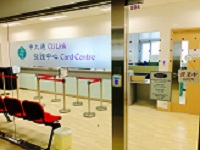- Home
- >
- About CU Link
- >
- History
| History – Major evolutions of CU Link |
2020 mid July – Change in the position of Mifare ID on CU LinkStarting from mid July 2020, Mifare ID will be printed at the back of the CU Link, and issue No. will not be printed. As Mifare ID is used as a token for generating bypass code for 2FA in case the user forgot to bring or lost his/her mobile (please click here for details), considering that students may need to provide photocopies of their student cards for student identity proof, printing Mifare ID at card back can avoid Mifare ID being provided to 3rd party. Remarks: 2019 CU Link with Contactless chip onlyStarting from 2009, there were 2 chips (contact and contactless chips) on CU Link. Due to the decommissioning of the contact chip, CU Link only has the contactless chip starting from 2019. For details of the decommissioning, please click here. 2017 Feburary – Enhanced Contactless chip Mifare PlusContactless chip was being used in CU Link card since 2009. After all these years, some new contactless technologies have been introduced in the market for better functionality and security protection. The University also replaces the aging technology in CU Link cards for enhancing the security protection of the use of CU Link cards in the University. Starting from February 2017, CU Link Card Centre issues new CU Link cards with contactless chip of new technology. 2015 May – Relocation of CU Link Card Centre
The CU Link Card Centre was moved to Room 804, 8/F, Wu Ho Man Yuen (WMY) Building in May 2015. 2010 July – Changes shown on CU Link in association with the implementation of new student database, CUSISWith the adoption of new 10-digit Student ID (SID) format without bearing with college affiliation starting from 1 Jul 2010, the new CU Link (Student Card) has been printed with additional particulars including college name of the student (for undergraduates) / the words “Graduate School” (for postgraduates), programme admitted and expiry date. 2009 February – New age of CU Link: Contact and contactless hybrid CardUpgraded version of CU Link contains both contact and contactless capabilities An upgraded version of CU Link was first issued on 16 Feb 2009. In contrast to the existing contact-based CU Link card where users need to insert the card into a card reader to perform a transaction, the upgraded version contains both contact and contactless capabilities in one card, giving University members the added convenience of tap-to-pass-through campus facilities (where contactless card readers are available). For cases that requires fast authentication, such as door access system and attendance taking system, the development of applications on contactless chip is definitely an advantageous solution. Tamper – proof label on contact-type cards
A card replacement exercise was carried out in the same period and all new cards issued were embedded with contact and contactless capacities. To be environmentally responsible, a green tamper-proof chip sticker (i.e. embedded with contactless chip) was introduced for contact-type cards expected to have a shorter term of use. 2008 September – Relocation of CU Link Card Centre
After a major renovation in 1/F Pi Chiu Building, the CU Link Card Centre was moved to Room 112 Pi Chiu Building . 2002 July – CU Link Card design reformation
With the fading out of Mondex, CU Link was reformed with the removal of bank functions. Since then, CU Link was re-designed to be an unique identity card for university members. 1999 October – The first issued Smart University ID Card, CU Link
The first CU Link was debut in October 1999 to replace the paper student and staff ID cards that had been used for over 30 years. Since then, it opens up new possibilities of the applications of smart card technology, using the highly secured MULTOS technology as Hong Kong Smart ID card does. Applications developed by ITSC include:
The CU Link Card Centre, located in G5 Pi Ch’iu Building, opened on October 28 1999, for staff and students to deal with all matters related to their CU Link. |









